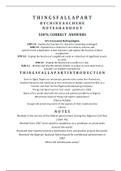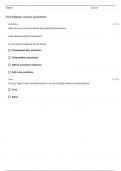th Edition by Theris A. Touhy and
Test Bank Ebersole and Hess Gerontological Nursing & HealthyAging 5
’
Kathleen F Jet Chapter 1- 28.
This is a bank of tests (study questions) to help you prepare for the tests.
To clarify,this is a test bank,not a textbook you have immediate access
To download your test bank!!!!!!!!!!!!!!!!!!!!!!!!!!!!!!!!!!!!!!!!!!!!!!!!
No delays loading is fast and instant immediately after
Purchase!
You will receive a full bank of tests, in other words,all chapters
Will be there.
Test banks are presented in PDF format;Therefore, no special
Software is Required to open them
Chapter 01: Introduction to Healthy Aging
Touhy & Jett: Ebersole and Hess Gerontological Nursing & Healthy Aging, 5thEdition
’
,MULTIPLE CHOICE
A man is terminally ill with end- stage prostate cancer. Which is the best
•
statement about thisman s wellness?
’
Wellness can only be achieved with aggressive medical interventions.
•
Wellness is not a real option for this client because he is terminally ill.
•
• Wellness is defined as the absence of disease.
Nursing interventions can help empower a client to
•
achieve a higher level ofwellness.
ANS: D
Nursing interventions can help empower a client to achieve a higher level of
wellness; a nursecan foster wellness in his or her clients. Wellness is defined by
the individual and is multidimensional. It is not just the absence of disease. A
wellness perspective is based on the belief that every person has an optimal
level of health independent of his or her situation or functional level. Even in the
presence of chronic illness or while dying, a movement toward wellness is
possible if emphasis of care is placed on the promotion of well- being in a
supportive environment.
PTS: 1 DIF: Apply REF: p. 7 TOP:
Nursing Process: DiagnosisMSC: Health Promotion and Maintenance
al R
N a IwG
llnBss.in
Ch M
alth care, which of the
•
In differentiating between he Uth S
ndNe Te Oe
following statements is true?
Health is a broad term encompassing attitudes and behaviors.
•
The concept of illness prevention was never considered by previous generations.
•
Wellness and self- actualization develop through learning and growth.
•
Wellness is impossible when one s health is compromised.
’
•
ANS: A
Health is a broad term that encompasses attitudes and behaviors; holistically,
health includes wellness, which involves one s whole being. The concept of
’
illness prevention was never considered by previous generations; throughout
history, basic self- care requirements have been recognized. Wellness and
self- actualization develop through learning and growth—as basic needs are
met, higher level needs can be satisfied in turn, with ever- deepening richness
to life. Wellness is possible when one s health is compromised—even with
’
chronic illness, with multiple disabilities, or in dying, movement toward a higher
level of wellness is possible.
PTS: 1 DIF: Understand REF: p. 7 TOP:
Nursing Process: EvaluationMSC: Health Promotion and Maintenance
, Which racial or ethnic group has the highest life expectancy in the United States?
•
Native Americans
•
African Americans
•
Hispanic Americans
•
Asian and Pacific Island Americans
•
Chapter 02: Cross- Cultural Caring and Aging
Touhy & Jett: Ebersole and Hess Gerontological Nursing & Healthy Aging, 5thEdition
’
MULTIPLE CHOICE
Which of the following is a true statement about differing health belief systems?
•
Personalistic or magicoreligious beliefs have been superseded in
•
Western minds bybiomedical principles.
In most cultures, older adults are likely to treat themselves
•
using traditionalmethods before turning to biomedical
professionals.
Ayurvedic medicine is another name for traditional Chinese medicine.
•
The belief that health depends on maintaining a balance among
•
opposite qualitiesis characteristic of a magicoreligious belief
system.
ANS: B
Older adults in most cultures usually have had experience with traditional
methods that haveworked as well as expected. After these treatments fail, older
adults turn to the formal healthcare system. Even in the United States, it is
common for older adults to pray for cures or wonder what they did to incur an
illness as punishment. The Ayurvedic system is a naturalistic health belief
system practiced in India and in some neighboring countries. This belief is
characteristic of a holistic or naturalistic approach.
PTS: 1 DIF: Understand REF: p. 16- 17
TOP: Nursing Process: Assessment MSC: Health Promotion and Maintenance
N
deR ati Ins GmBst.liC
k My to be true when working
•
Which of the following consi Ur So N is To O el
with an interpreter?
An interpreter is never needed if the nurse speaks the same language as the patient.
•
When working with interpreters, the nurse can use technical terms or metaphors.
•
, A patient s young granddaughter who speaks fluent English
’
•
would make the bestinterpreter because she is familiar with and
loves the patient.
The nurse should face the patient rather than the interpreter.
•
ANS: D
The nurse should face the patient rather than the interpreter is a true
statement; the intent is to converse with the patient, not with a third party about
the patient. Many reasons may prevent the patient from speaking directly to a
nurse. Technical terms and metaphors may be difficult or impossible to translate.
Cultural restrictions may prevent some topics from being spoken of to a
grandparent or child.
PTS: 1 DIF: Understand REF: p. 18- 19
TOP: Nursing Process: Implementation MSC: Safe, Effective Care Environment
An older adult who is a traditional Chinese man has a blood pressure of 80/54
•
mm Hg and refuses to remain in the bed. Which intervention should the nurse
use to promote and maintainhis health?
Have the health care provider speak to him.
•
Use principles of the holistic health system.
•
Ask about his perceptions and treatment ideas.
•
Consult with a practitioner of Chinese medicine.
•
ANS: C
Using the LEARN model (listen with sympathy to the patient s perception of
’
the problem, explain your perception of the problem, acknowledge the
differences and similarities, recommend treatment, and negotiate agreement),
the nurse gathers information from the patient about cultural beliefs concerning
health care and avoids stereotyping the patient. In theassessment, the nurse
determines what the patient believes about caregiving, decision making,
treatment, and other pertinent health- related information. Speaking with the
health care provider is premature until the assessment is complete. Unless he
accepts the beliefs, principles of the holistic health system can be potentially
unsuitable and insulting for this patient. Unless he accepts the treatments,
consulting with a practitioner of Chinese medicine can also be unsuitable and
insulting for this patient.
PTS: 1 DIF: Apply REF: p. 18
TOP: Nursing Process: Implementation MSC: Health Promotion and Maintenance
Which action should the nurse take when addressing older adults?
•






